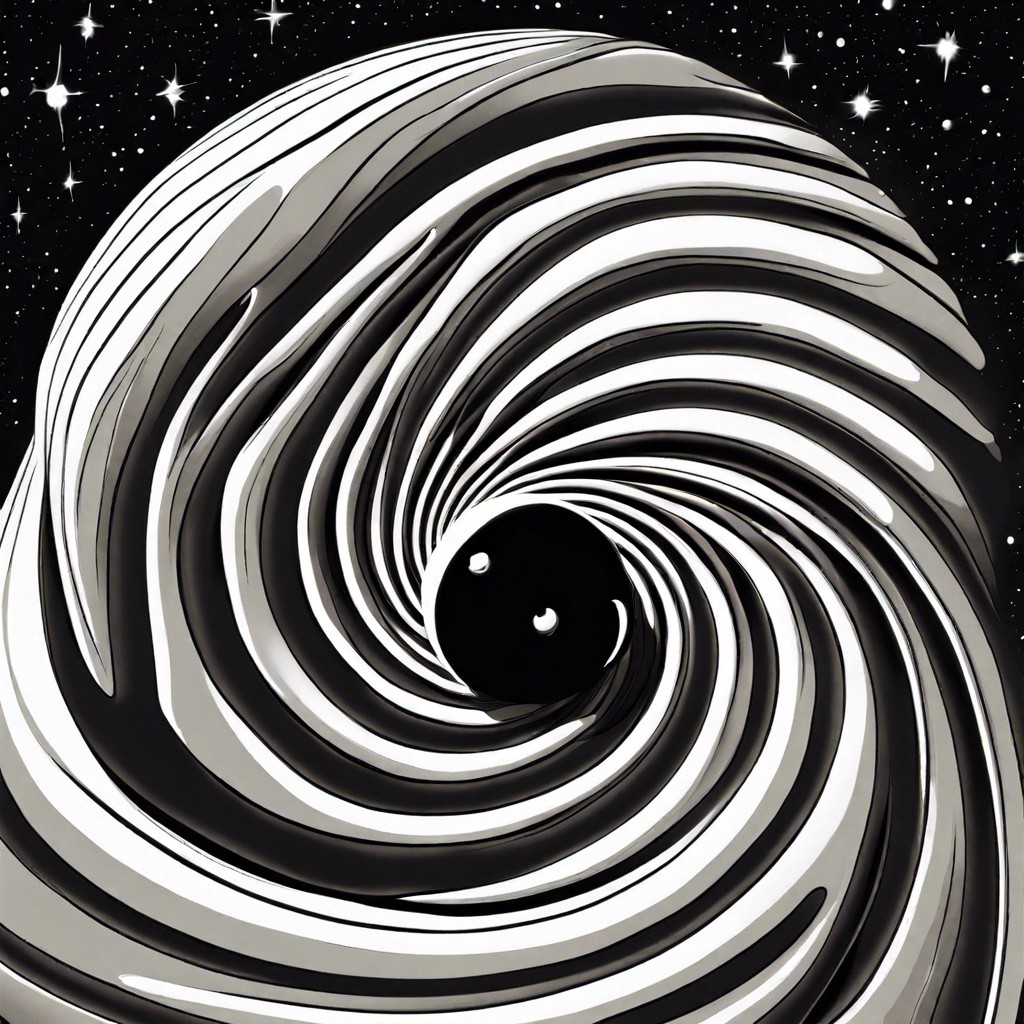When two black holes collide, they create gravitational waves, emit massive amounts of energy, and form an even larger black hole.
Ever wondered what happens when two titanic voids decide to tango? When black holes collide, they unleash a cosmic extravaganza, complete with gravitational waves, a warped space-time, and maybe even a black hole baby. Buckle up, because we’re diving into all the thrilling details—gravitational waves, space-time shenanigans, colossal collisions, and the epic aftermath. This is the crash course you’ve been looking for!
Key takeaways:
- Gravitational waves announce epic cosmic collisions.
- Space-time warps, stretches, and twists during the collision.
- Colliding black holes form a single, larger black hole.
- Energy released converts mass into unimaginable energy.
- Observational methods like LIGO and telescopes detect collision evidence.
Gravitational Waves: The Cosmic Ripples

Imagine dropping a stone into a calm pond. Ripples spread out, right? When two black holes collide, they create ripples too, but in the fabric of space-time. Scientists call these ripples gravitational waves. They’re essentially the universe’s way of announcing, “Something epic just happened!”
These waves travel at the speed of light, zipping through the cosmos. They stretch and squeeze space, but don’t worry, it’s not enough to scramble your eggs.
Albert Einstein first predicted them, but it wasn’t until 2015 that humans finally heard them, thanks to the LIGO observatory. Those detectors are like cosmic eavesdroppers, listening for the faint whispers of distant cataclysms.
Gravitational waves help us understand black holes better. They let us peek into otherwise dark phenomena, making the invisible, well, a bit more visible.
Impact On Surrounding Space-Time
When two black holes tango, space-time itself gets quite the shock. Picture it like a bowling ball on a trampoline, but on a cosmic scale. Now multiply that by a gazillion.
First, there’s the warping effect. Space-time gets stretched, squeezed, and twisted like an overzealous piece of taffy. Distances can get messed up, so don’t rely on your cosmic yardstick.
Next up, tidal forces. Anything—stars, dust, maybe the odd spaceship—caught near this cosmic mash-up will experience intense gravitational forces. It’s like being on the universe’s most extreme roller coaster.
Finally, there’s the kick. The new black hole formed might zoom off like a cosmic bulldozer, relocating to a new patch of space-time. Hold on to your telescopes, folks!
Formation of a Larger Black Hole
Imagine two cosmic titans meeting for a grand dance, only to become one even grander entity by the end. When black holes collide, the gravitational tussle results in the merging of singularities. Here’s what to know:
– Size Matters: The resulting black hole is more massive than either of the original ones, yet it doesn’t quite add up because a chunk of mass gets converted into energy.
– Einstein Shouts “I Told You So”: The merge aligns perfectly with his theory of general relativity, as the massive energy release forms gravitational waves.
– Spin the Bottle (or Black Hole): The newly born black hole can have a high spin rate, decided by the spins and angles of the original black holes.
– Event Horizon Pay-Per-View: The event horizon of the new black hole will be larger, absorbing any matter and light that strays too close, without any apologies.
It’s a celestial phenomenon where giant cosmic recycling meets high-energy physics, creating ripples across the universe and making even Einstein do a cosmic jig.
Energy and Matter Ejection
When two black holes decide to have a cosmic smackdown, you’d expect some pretty wild energy fireworks. And guess what? You wouldn’t be wrong.
Imagine taking two colossal whirlpools and smashing them together. The energy released during this process is unimaginably massive. Lightning bolts on steroids? Nah, even more insane.
Fun fact: A significant portion of mass can get converted into energy, according to Einstein’s famous equation E=mc^2. In other words, quite a bit of mass does a nifty vanishing act and transforms into pure energy.
Does matter get ejected during this event? While most of it plunges into the dark abyss, there are scenarios where gas and dust around the black holes can be flung out at absurdly high speeds. Think of a cosmic slingshot, hurling particles across space like there’s no tomorrow.
To keep things spicy, these high-speed particles can produce jets of radiation. Imagine super-sized laser beams shooting out into the cosmos. These bursts are so powerful that they ripple through space-time, making astronomers jump up and down with excitement. They might even spill their coffee.
Observational Methods and Evidence
Fancy gadgets alert! Detecting the cosmic clash of titans starts with instruments like LIGO (Laser Interferometer Gravitational-Wave Observatory) and Virgo. These marvels of modern science can catch the faint ripples in space-time caused by black hole mergers. Think of it as listening for an ant’s footsteps but for astrophysicists.
Now, radio telescopes also get in on the action. They hunt for the electromagnetic signals—like gamma-ray bursts—that sometimes accompany these cosmic events. Imagine the universe throwing a fireworks party and scientists popping their telescopes like confetti cannons to catch the light show.
Don’t forget about supercomputers! Yes, those big ol’ digital brains chew through mountains of data to create simulations. They help make sense of the chaotic aftermath and verify that the black hole ballet our telescopes saw wasn’t just a cosmic mirage.
And finally, there’s the good ol’ optical telescope. While not as flashy in this context, they can sometimes catch afterglows or other peculiar glimmers. Think of them as the eagle-eyed snipers in the squad, ready to spot what others can’t.




